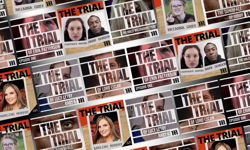Those of us who have been around the world of journalism for more than just a few years used to swear by it. It was the source of timely, trusted information. It was The Wire.
I refer, of course, to the Press Association news wire - the rapidly-updated service of news from across the UK and the world that news organisations clung to like a comfort blanket.
Oh how excited we used to get in regional newsrooms when the big stories broke and we had editions through the day to publish them. Those were the days when the now-long-gone job of Copy Taster was one of the most sought-after in the newsroom. They were, after all, The Watcher of The Wire.
That’s all changed now. The PA wire remains a hugely authoritative and credible news source, but, like so much in journalism, it is being disrupted by platforms that enable the public to become publishers. The Wire has been superseded by Twitter - the world’s most powerful, unpredictable, entertaining and addictive news machine. I joined Twitter a year ago and now find it indispensible.
Many journalists have embraced Twitter with passion, personality and purpose, but some have held back. I don’t understand that - how can any journalist fail to see that Twitter should be their personal news wire?
So, if you’re a journalist who hasn’t joined the Twittersphere yet, here are ten reasons to do it - today!
1 To get stories - lots of them
Twitter is awash with stories of all kinds and, when news breaks, it invariably breaks first on Twitter. Things happen and people tweet about them. Take Sohaib Athar. Who? He was the man who inadvertently live-tweeted the raid on Osama bin Laden’s compound in Pakistan. When Whitney Houston died, the news was first published by a Twitter user whose aunt apparently worked for the singer. That tweet appeared 42 minutes before the news was confirmed - on Twitter - by Associated Press.
Now, when something happens, the reporter is competing to break the story not just with rival journalists, but any witness armed with a smartphone. Within seconds a “citizen journalist” can tweet the story. A professional journalist who rings into the newsdesk to pass on the news is left trailing in their wake.
You see it at all levels of the news pyramid. My focus is largely on news from East Yorkshire and the Humber region and every day I am struck by how often stories appear in my Twitter timeline before they are published by mainstream media.
There are many reasons for that. Organisations sometimes bury news on their websites or Facebook pages, but now, more often than not, they tweet links to new content on those sites. People also let their defences down on social media. A throwaway comment on Twitter can become a splash.
2 To remain relevant
If you haven’t noticed, the world is on Twitter. There are 465 million accounts worldwide and 23 million in the UK. Very few organisations or businesses have yet to be seduced by it.
The Twitter accounts I follow include four local MPs and other politicians, major local businesses, key local networks, journalists from the Hull Daily Mail, Yorkshire Post and BBC, and other important influencers. Twitter enables me to follow them and interact with them, in real time, on issues that matter to them and to me.
Twitter has matured into a credible platform for news, opinion and debate. It is popular and powerful and becoming more so daily. Any journalist who fails to embrace it risks irrelevance.
3 To be part of the conversation
The monologue model of news dispensed from publisher to reader is over. Now journalists are part of a much more fluid conversation between news makers and news consumers. You simply have to be part of that conversation - and Twitter is a perfect way to do that.
It’s vital to understand that Twitter is fundamentally about sharing - sharing news, observations, insights, perspectives and so much more. Journalists can build a following and credibility on Twitter by taking and giving - mining the Twittersphere for stories, angles and case studies, but also passing on their insights and knowledge and sharing other users’ tweets.
4 To build contacts and relationships
Twitter is a great way to build your profile and to develop contacts and trusted relationships. You can build bonds through the people you follow, by retweeting and commenting on their posts and engaging in conversation with them.
For example, I have developed productive relationships with journalists and other influencers who I haven’t even met, or barely know, by doing this. Those virtual relationships have borne fruit in the “real world”.
One tip to help this - make a habit of name-checking specific Twitter accounts in your tweets. That means they get noticed. I can assure you that, if somebody refers to @MeehanMedia in a tweet, I will see it and often reply or engage in conversation with the person who posted it.
5 To develop your journalistic credibility and trust
Twitter offers a wonderful opportunity to reinforce the credibility you have as a trusted source of accurate, independent, well-researched news and opinion.
A good journalist - especially a specialist writer - can become very quickly established as a Twitter voice to trust - someone who cuts through the noise; who separates truth and rumour; who has the skills to stand out in the crowd.
Recently, I witnessed an excellent example of how a journalist can “own” an issue on Twitter. Jack Blanchard, political editor of the Yorkshire Post, used his @JackBlanchardYP account to micro-blog a Commons debate on the so-called Caravan Tax, which could result in 3,000 job losses in East Yorkshire. Jack’s running commentary would have graced any newswire, but it also included asides and insights. It was a textbook example of using new technology to aid rapid-fire story-telling.
6 To filter the “noise” and be a filter for others
American digital guru Clay Shirky famously observed: “There’s no such thing as information overload, just filter failure.” Of course, that’s too simplistic, but it’s also fundamentally true. There is way too much information available to us all, courtesy of the internet, but the web also offers so many ways to filter it.
With Twitter you set and re-set the filters by deciding who you will follow and, therefore, whose tweets appear in your timeline. I find myself regularly adding and deleting accounts from my following list, to keep it both informative and manageable.
For example, I began to follow former footballer Dean Windass, a Hull City legend, after he revealed he was going into treatment for depression after attempting suicide. Several interesting tweets followed as Windass underwent rehab. Now that he’s back on track and tweeting about football and not much else, I’ve unfollowed him. No offence, Deano. I’m really pleased you’re so much better, but I’ve got to make sure my timeline doesn’t get too crowded.
So Twitter itself is a filter, but so is the journalist’s news radar. You can spot the gems and share them with your followers. You can become an information filter for others.
And, while Twitter democratises the news dissemination process, it also highlights the need for professional journalists to verify, analyse and contextualise what is tweeted. Is it true? Is it credible? What does it mean? The professional journalist can answer all those vital questions.
7 To gain feedback and gauge public opinion
Build a sizeable audience on Twitter and you create your own sounding board. You can judge how interested people are in your stories and the issues you focus on by the number of retweets, mentions and replies you receive. You can ask for opinions and seek case studies from your followers and, because they find you interesting and informative, they are much more likely to respond.
8 To hone your journalistic skills
Twitter is also a great way to showcase and hone your writing and editing skills.
One client said to me: “You write your tweets like headlines, don’t you?” And he was right, in a way. Having written headlines for more years than I care to remember, I know how to communicate meaningfully despite the 140-character limit. It’s a great discipline and one that helps you to focus on the key elements of a story or issue.
Sad it might be, but I really enjoy getting maximum value from those 140 characters, without resorting to textspeak or ugly abbreviations. I’m also careful to avoid literals. Punchy, but literate and error-free tweets differentiate the professional from the amateur.
9 To promote your media brand
Twitter is an immediate, very personal medium and, therefore, an exceptionally powerful medium. It offers fantastic opportunities to reinforce media brands.
Traditional media such as newspapers and broadcasters should, and do, tweet as the brand, but the greatest power is in their journalists, their editors and star writers, communicating with followers. They can engage personably with users to promote their media organisation and its continuing relevance and influence. This is especially vital for newspapers, when so much is heard about the decline of print journalism.
10 To build your personal brand
Finally, journalists should recognise that Twitter is a great personal opportunity. Building your own brand on Twitter makes you more likely to evade the budget axe, more likely to be valued by your employer, and more attractive to others.
Last year, political correspondent Laura Kuenssberg was poached by ITV from the BBC, taking more than 60,000 Twitter followers with her, in a high-profile illustration of the value of the journalist as a brand.
Of course, a regional journalist won’t amass that many followers, but they can build significant audiences. In my part of the world, BBC presenter Peter Levy has 12,000 Twitter devotees; Yorkshire Post business editor Bernard Ginns close to 3,000; and Hull Daily Mail rugby league writer James Smailes almost 1,800. All have substantial personal audiences that they have worked hard to develop. I’m sure their employers recognise the value their social media influence adds to their organisations.
It may seem selfish, but aren’t self-preservation or career progression good enough reasons alone to get into Twitter? In these difficult times for journalism, I’d certainly say so.










